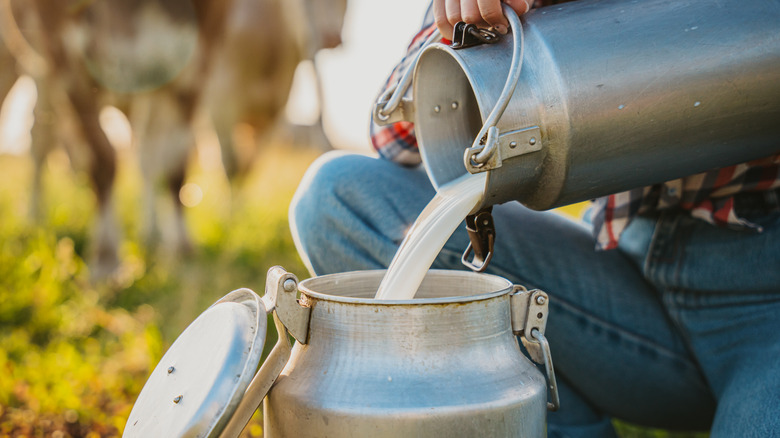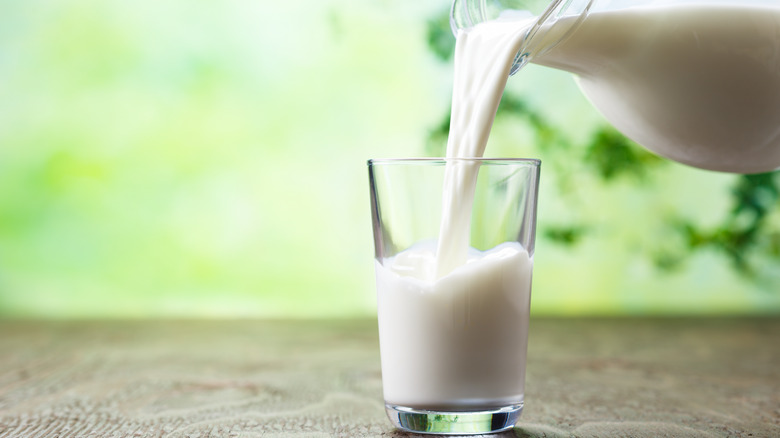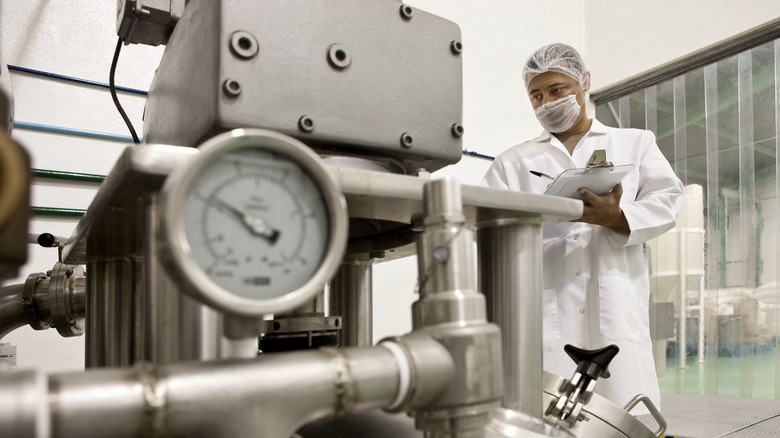The Dangers Of Raw Milk You Won't Hear About On TikTok
It's nothing new — since the dawn of social media, and long before, it's been all too easy for false, misleading, and potentially even downright dangerous food info to spread across the internet and into people's kitchens. There was the era of the low-calorie craze, the days fat was the foe, and now, there's a new kid on the block of trendy "fad" dietary advice. Picking up steam specifically on TikTok, there's a growing hype surrounding raw milk, with creators and influencers in the food and wellness space taking to their platforms to talk up the alleged benefits of sipping the unpasteurized stuff. Their claims include that raw milk is easier for the body to digest, contains higher amounts of gut-healthy pre- and probiotics, and is richer in naturally occurring vitamins and minerals.
Unfortunately, like so many pieces of fast fad, gimmicky dietary "advice," the science doesn't support the supposed benefits that raw milk proponents advertise. Not only is raw milk no healthier than standard pasteurized dairy, per the FDA, but there's a wealth of research clearly demonstrating that raw milk consumption can be downright dangerous. Consuming the bacteria and viruses it can contain leads to a host of severe gastrointestinal woes and more serious, potentially even deadly side effects.
Raw milk can cause digestive woes, and far worse
Outlandish, unfounded, and demonstrably false food facts have made the rounds over the last 50 years — and no doubt, more falsehoods will come. The raw milk hype is particularly dangerous, though, due to the effects that can come from consuming the harmful bacteria that linger in raw dairy. The FDA classifies raw milk as cow's milk, or dairy from goats or sheep, as it is straight from the animal — without undergoing the standard safety protocol of pasteurization, as most store-bought milk is.
This raw milk is fit for baby animals to drink, but when people consume it they run the risk of taking in dangerous pathogens like Salmonella bacteria, E. coli, Listeria and many others. These bacteria are the cause of hundreds of cases of food poisoning every year and can wreak havoc in even more severe ways on certain members of the population, such as those who are immunocompromised, babies and children, or the elderly.
If you drink some unwanted bacteria along with your raw milk, don't be fooled — the result isn't just a tummy ache or some run-of-the-mill digestive woes. Potentially, you could be looking at severe effects ranging from vomiting, flu-like symptoms, fever, bloody diarrhea, and even potentially deadly conditions like kidney failure and paralysis. Mycobacterium bovis, a bacteria that can cause tuberculosis in humans, even lingers in raw milk.
Pasteurization has been the dairy food safety standard for centuries
Proponents of the raw milk "trend" equate drinking unpasteurized milk with a homespun, idyllic, and "back to nature" approach — plus greater nutrition and health benefits. The data-backed reality is more grim, according to the FDA. Pasteurization is the process most storebought milks undergo, of heating liquids to very high temperatures for short bursts. This heat kills off harmful, potentially deadly bacteria and pathogens without compromising the taste or nutritional value of the dairy.
Since way back in the 1860s, when Louis Pasteur invented pasteurization, the technique has been widely employed (it's even used with non-dairy milks, including almond). Pasteurization radically cut down on rates of foodborne illness and diseases like tuberculosis, diphtheria, and typhoid fever that were once commonplace. It's worth noting, no matter what TikTokers purport, that a whopping 70% of modern-day milk-related disease outbreaks are due to raw milk consumption.
Just how likely are you to ingest bacteria and pay the consequences if you choose to drink raw, unpasteurized milk? The numbers vary, but one study examining a random 100 samples of milk, detailed in the Journal of Preventative Medicine and Hygiene, found dangerous bacteria contaminating up to 42% of the samples tested, making this current trend not just skippable but highly dangerous. TLDR; this isn't a food trend you want to play fast and loose with — take it from the scientists, not the TikTokers.


